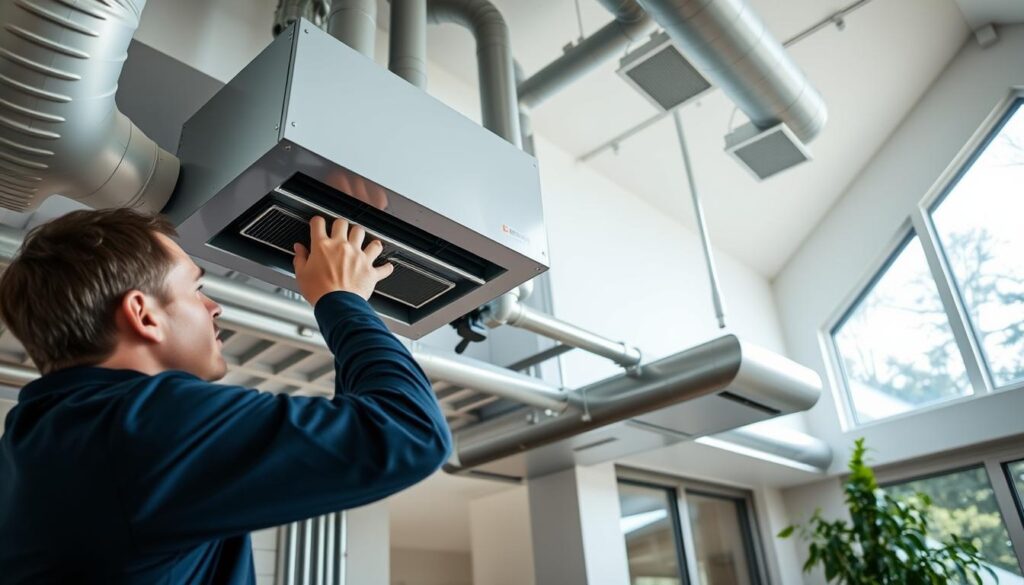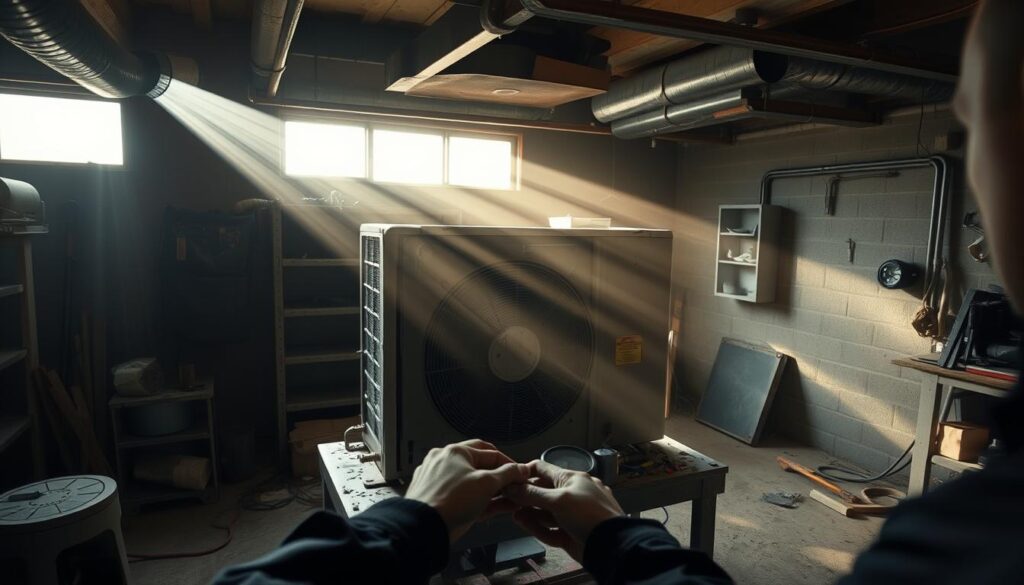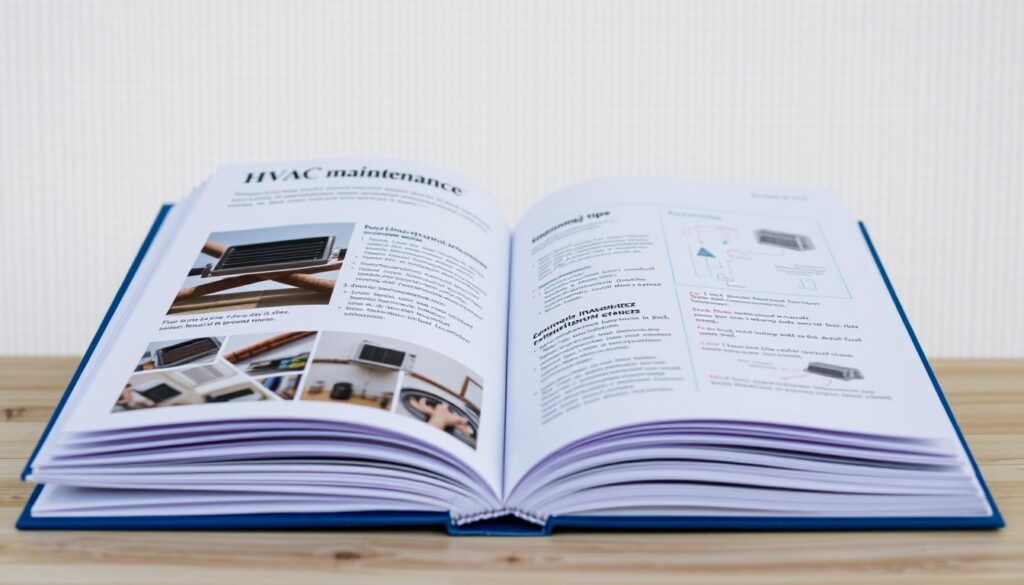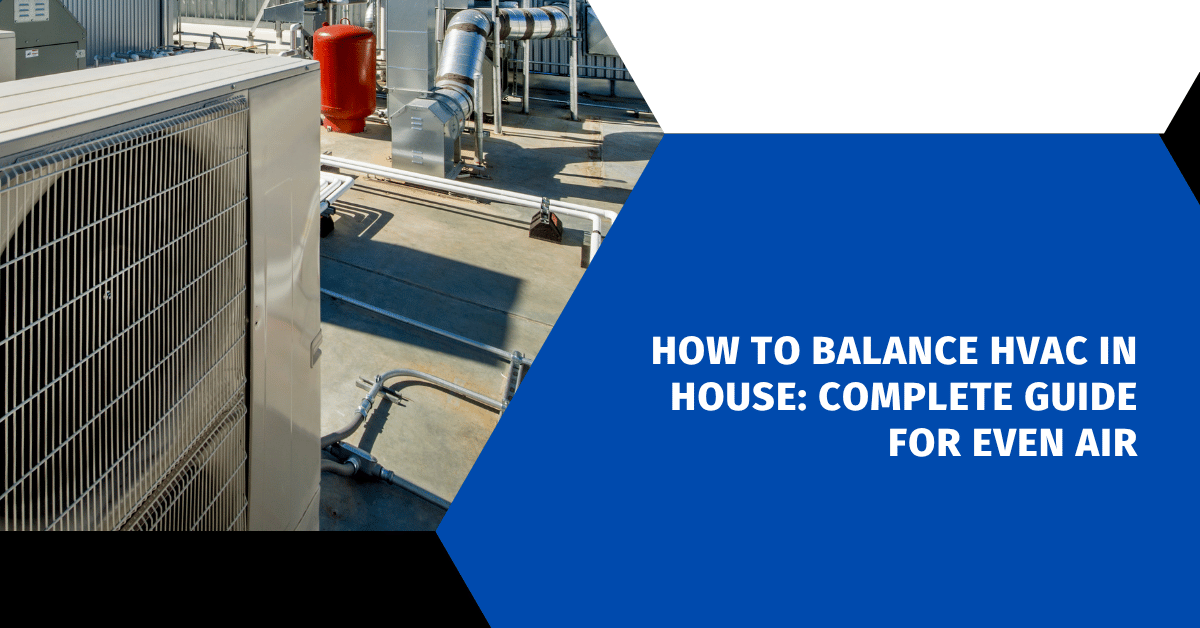Affiliate Disclosure
HVAC Guide Guys is a participant in the Amazon Services LLC Associates Program, an affiliate advertising program designed to provide a means for sites to earn advertising fees by advertising and linking to Amazon.
Are you tired of walking from a freezing bedroom to a sweltering living room in your own home? What if you could achieve perfect temperature consistency throughout every space?

Balancing your HVAC system is the secret to achieving even temperature distribution in your home. Learning how to balance HVAC in house can transform your comfort and energy efficiency. It eliminates those frustrating hot and cold spots that disrupt your daily life.
Your home’s heating and cooling system isn’t just about pushing air through vents. It’s about strategically managing airflow to create a comfortable living environment. By understanding and implementing proper air balancing techniques, you can optimize your HVAC system’s performance. This creates a more comfortable living space.
Key Takeaways
- HVAC balancing ensures consistent temperature across all rooms
- Proper air distribution reduces energy waste
- DIY techniques can improve home comfort
- Regular system maintenance prevents uneven cooling
- Professional assessment can identify complex airflow issues
Table of Contents
Understanding HVAC Air Balancing Basics
Your home’s comfort is more than just an HVAC system. Proper HVAC zoning is key for a comfortable home. Air balancing ensures the right temperature in every room.
What is Air Balancing?
Air balancing adjusts your heating and cooling for even air flow. It uses balancing dampers to control air in different areas. The aim is to keep all rooms at a consistent temperature, avoiding hot and cold spots.
Why Your HVAC System Needs Balancing
- Improve overall system efficiency
- Reduce energy consumption
- Enhance home comfort
- Extend HVAC system lifespan
An unbalanced HVAC system works too hard, leading to high energy bills and wear. Proper HVAC zoning optimizes your system’s performance and comfort.
Signs of an Unbalanced System
Spotting an unbalanced HVAC system is crucial for comfort. Look out for these signs:
- Temperature variations of more than 2-3 degrees between rooms
- Rooms that feel consistently too hot or too cold
- Unusually high energy bills
- Weak airflow from some vents
Balancing dampers are vital in fixing these problems. They help fine-tune your home’s air flow for better comfort.
Essential Tools and Equipment for HVAC Balancing
Adjusting airflow in your home needs special tools. These tools help you measure and control your HVAC system’s performance. Whether you’re doing it yourself or you’re a pro, the right tools are essential for adjusting registers and balancing air.
Both professional and home-use tools are important for good airflow. Knowing about these tools lets you make accurate measurements and adjust your heating and cooling system as needed.
Essential HVAC Balancing Tools
- Anemometer: Measures air velocity and volume at vents
- Digital thermometer for precise temperature readings
- Adjustable screwdriver set
- Pressure gauge
- Smoke pencil for airflow visualization
Specialized Measurement Equipment
| Tool | Purpose | Recommended For |
|---|---|---|
| Vane Anemometer | Measure air velocity | Residential HVAC systems |
| Flow Hood | Measure total airflow | Commercial spaces |
| Differential Pressure Meter | Check system pressure | Advanced diagnostics |
Quality tools are key for precise register damper adjustment. They help keep your home comfortable. Remember, accurate measurements are crucial for balancing your HVAC system well.
Explore Our HVAC Shop
Looking for top-rated HVAC tools, parts, and accessories? Visit our shop and find the perfect solution for your needs.
Visit the ShopHow to Balance HVAC in House: Step-by-Step Process
Balancing your HVAC system is key to keeping your home comfy. It’s a process that needs focus and specific techniques. Anyone can learn these steps with the right guide.
First, know that HVAC balancing spreads air evenly in your home. It’s a precise task.
Initial System Assessment
Begin by checking your HVAC system closely. You should:
- Find the main heating and cooling unit
- Follow the ductwork system
- Spot all supply and return vents
- Look for blockages or damage
Measuring Current Airflow
Getting accurate airflow measurements is crucial. Here’s what to do:
- Turn on the fan
- Use an anemometer to measure airflow at each vent
- Record the CFM for each room
- Compare to recommended rates
Making Necessary Adjustments
After measuring, fine-tune your system. Adjust dampers and louvers to improve airflow. This might mean closing vents in cool rooms to warm others.
Pro Tip: Balancing is an iterative process. Be patient and make small adjustments, then remeasure to ensure optimal results.
Proper HVAC balancing boosts your home’s comfort and energy use. Take your time and be detailed in your steps.
Understanding Dampers and Vents
HVAC airflow management depends on dampers and vents. These parts are key to balancing air flow in your home. Knowing how to adjust them can make your heating and cooling system work better.
Types of Dampers in HVAC Systems
Dampers are like valves in your ductwork that control air flow. There are different types:
- Manual dampers: Need to be adjusted by hand
- Motorized dampers: Work with electronics for exact control
- Automatic balancing dampers: Adjust air flow on their own
Proper Vent Adjustment Techniques
To adjust vents right, start by finding rooms with uneven temperatures. Open or close vents a bit to move air around. This helps balance the air in your home.
Common Adjustment Mistakes to Avoid
Many people make mistakes when adjusting dampers:
- Shutting vents in rooms not used
- Not checking damper settings
- Ignoring how air flows through the system
Pro tip: Always make small changes and watch your home’s temperature for the best results.
Learning to balance dampers and adjust vents can greatly improve your HVAC system. It ensures your home stays comfortable all the time.
Room-by-Room Balancing Techniques
To get even temperatures in your home, you need a smart plan for each room. Every space has its own heating and cooling needs. These depend on its size, where it is, and how it’s used.
Every room has its own comfort challenges. Big rooms with lots of sunlight or windows need special airflow. This is different from smaller, inside rooms.
- Measure each room’s current temperature
- Identify areas with significant temperature variations
- Adjust individual vent openings accordingly
- Use dampers to control airflow precisely
Creating a balanced HVAC system is your goal. Patience is key. It might take weeks to get the temperatures just right.
“Consistent comfort is about understanding each room’s unique characteristics and responding accordingly.” – HVAC Comfort Experts
Pay extra attention to certain rooms. These include:
- Sunny living areas
- Rooms with large windows
- Top floor spaces
- Basement or ground-level rooms
Using tools like digital airflow meters can help. They make it easier to adjust your HVAC for even temperatures in your home.
Explore Our HVAC Shop
Looking for top-rated HVAC tools, parts, and accessories? Visit our shop and find the perfect solution for your needs.
Visit the ShopTroubleshooting Common Airflow Issues
Keeping your home at a steady temperature can be tough. Airflow problems make your home uncomfortable and lower your HVAC’s efficiency. Learning to adjust airflow is key for a cozy home.

Finding airflow issues takes careful watching and a detailed check. Look out for these signs:
- Rooms with dramatically different temperatures
- Inconsistent cooling across different areas
- Unusual system noises
- Increased energy consumption
Identifying Problem Areas
Begin by checking each room’s temperature. Use a digital thermometer to spot big temperature gaps. Rooms with more than 3-4 degree differences need airflow work.
Solutions for Uneven Cooling
To fix uneven cooling, try these steps:
- Check and replace dirty air filters
- Inspect and seal duct leakages
- Adjust damper settings
- Verify fan speed configurations
Fixing Hot and Cold Spots
To solve temperature issues, get professional duct testing and balancing. Complex airflow problems might need special tools and expert help. Some homes might need more return air paths or vent changes for better air flow.
“Proper HVAC balancing transforms your home’s comfort level and energy efficiency.” – HVAC Expert
By tackling airflow problems, you can make your home more comfortable. You’ll get even temperatures everywhere.
Advanced HVAC Balancing Methods
Exploring advanced HVAC balancing techniques can change how you manage your home’s climate. Professional HVAC experts use new technologies for precise proper hvac zoning and optimal air distribution.
Modern HVAC balancing is more than just manual adjustments. It includes:
- Computerized airflow modeling
- Infrared thermal imaging
- Smart automated zoning systems
- Digital airflow measurement tools
These advanced methods offer unmatched precision in climate control. Infrared thermography lets technicians see exact heat patterns and temperature changes in your space.
| Technology | Primary Function | Accuracy Level |
|---|---|---|
| Digital Airflow Modeling | Simulate Air Distribution | 95-99% |
| Smart Zoning Systems | Customize Room Temperatures | 90-97% |
| Thermal Imaging | Detect Temperature Variations | 92-98% |
Smart home integration lets you control your HVAC system remotely. This gives you unmatched control over your indoor environment. By using these advanced techniques, you can enjoy optimal comfort and save energy.
Explore Our HVAC Shop
Looking for top-rated HVAC tools, parts, and accessories? Visit our shop and find the perfect solution for your needs.
Visit the ShopMaintaining Balanced Airflow Year-Round
To keep your HVAC system balanced all year, you need a plan and regular upkeep. Proper hvac zoning makes sure every room is comfy. It also saves energy.

Seasons change, and so do your home’s heating and cooling needs. To balance HVAC in house, you must manage your system well.
Seasonal Adjustment Strategies
- Adjust thermostat settings for summer and winter temperature differences
- Clean or replace air filters every 30-90 days
- Check and seal ductwork before extreme temperature seasons
- Inspect and clean outdoor HVAC units quarterly
Comprehensive Maintenance Schedule
| Season | Maintenance Tasks | Frequency |
|---|---|---|
| Spring | AC system tune-up | Annually |
| Fall | Heating system inspection | Annually |
| Year-round | Air filter replacement | Every 1-3 months |
Stick to these maintenance tips to make your HVAC system work better. You’ll save on energy bills and keep your home comfy all year.
Regular maintenance is the key to long-lasting HVAC efficiency and balanced airflow.
When to Call a Professional
Dealing with hvac balancing can be tough for homeowners. Some small tweaks are okay, but bigger issues need a pro. Knowing when to call an HVAC expert can save you time, money, and prevent damage.
There are a few times when you really need a pro:
- Persistent temperature issues in different rooms
- Complicated ductwork
- Old HVAC systems with zoning problems
- Unexplained drops in energy efficiency
Certified HVAC techs have the right tools and know-how for hvac zoning. They use advanced gear to check airflow, fan speed, and ductwork.
Here’s what you get from a pro:
- Accurate airflow checks
- Deep system performance reviews
- Custom fixes for your home
- Improved energy use over time
When picking a pro, look for certified techs with hvac balancing experience. Ask about their diagnostic methods, tools, and what they promise before you book.
Professional HVAC help can make your home more comfortable and energy-efficient.
Getting a pro for hvac balancing might cost more at first. But, it can avoid costly fixes and cut down energy bills in the long run.
Explore Our HVAC Shop
Looking for top-rated HVAC tools, parts, and accessories? Visit our shop and find the perfect solution for your needs.
Visit the ShopCost Considerations and Energy Savings
Getting your HVAC system balanced might seem like an extra cost. But, it’s a wise choice for homeowners. It boosts comfort and saves a lot on energy.
Professional HVAC balancing services cost around $100 per vent or opening. At first, it might seem pricey. But, the long-term savings are worth it.
Investment Breakdown
Let’s look at the money side of getting even temperatures in your home:
- Initial professional service cost: $300-$600
- Potential annual energy savings: 10-15%
- Estimated utility bill reduction: $100-$250 per year
Energy Efficiency Benefits
A balanced HVAC system brings many financial perks:
| Benefit | Estimated Value |
|---|---|
| Reduced Energy Consumption | Up to 15% lower utility costs |
| Extended HVAC System Lifespan | 2-5 additional years of operation |
| Improved Home Comfort | Consistent temperature in all rooms |
Investing in HVAC balancing improves your home’s comfort. It also saves you money over time by using less energy.
Conclusion
Learning to balance HVAC in your home is more than just a skill. It’s about making your living space comfortable. The way your home’s temperature is distributed affects both comfort and energy use. By learning about air balancing, you can make your home always feel just right.
Getting to even temperature distribution takes time, patience, and a desire to learn. You can do it yourself or get help from HVAC experts. The main thing is to see how important it is to manage airflow well. Regular checks and upkeep keep your system running smoothly and avoid big problems.
Putting effort into HVAC balancing brings big rewards. You’ll feel more comfortable, use less energy, and maybe even save on bills. Your system will work better, last longer, and won’t wear out as fast. Remember, keeping up with your system is key to a well-balanced home climate.
Start making your home more comfortable today. Follow the tips from this guide. Your effort in understanding and caring for your HVAC system will make your home more comfortable, efficient, and last longer.

